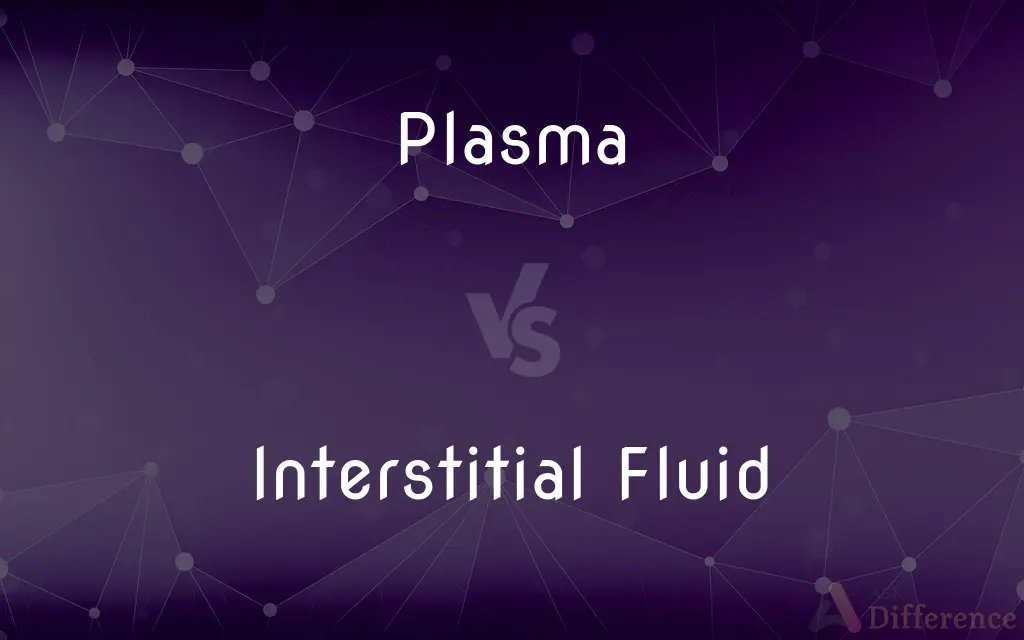Plasma vs. Interstitial Fluid — What's the Difference?
Edited by Tayyaba Rehman — By Fiza Rafique — Published on December 29, 2023
Plasma is the liquid component of blood without cells; Interstitial Fluid is the fluid between cells in tissues. Both are bodily fluids, but occupy different compartments.

Difference Between Plasma and Interstitial Fluid
Table of Contents
ADVERTISEMENT
Key Differences
Plasma is the clear, straw-colored liquid portion of blood that remains after removal of blood cells. It constitutes about 55% of the volume of blood. This component of blood serves as a transport medium for glucose, lipids, hormones, and waste products. In contrast, Interstitial Fluid is the fluid found in the spaces between cells, commonly referred to as tissue spaces. It originates from the blood plasma but has a different composition due to selective permeability of cell membranes.
Plasma contains a higher concentration of proteins compared to Interstitial Fluid. This includes albumin, fibrinogen, and globulins. These proteins play a significant role in maintaining osmotic balance and various other functions in the bloodstream. On the other hand, Interstitial Fluid has a lower protein concentration since many large proteins cannot easily pass out of the capillaries.
The primary role of Plasma is to act as a transport medium within the circulatory system. It carries cells, nutrients, metabolic waste products, and various molecules across the body. Interstitial Fluid, however, acts as a medium for exchange between blood in the capillaries and body cells. It delivers nutrients to the cells and takes away waste products.
Another distinction lies in their respective locations. Plasma is exclusively found within the vascular system, i.e., inside the blood vessels. Conversely, Interstitial Fluid is located outside the blood vessels, occupying the spaces between the cells in tissues. It's noteworthy that a dynamic equilibrium exists between these fluids, with water, ions, and small solutes continuously exchanged to maintain homeostasis.
A balance between Plasma and Interstitial Fluid is essential for optimal body function. Any disruption in this balance, like in edema, can lead to health complications. While Plasma contains clotting factors that help in blood coagulation, Interstitial Fluid lacks these, making it non-coagulable.
ADVERTISEMENT
Comparison Chart
Location
Inside blood vessels
Between cells in tissues
Protein Concentration
Higher concentration
Lower concentration
Function
Transport medium within blood
Exchange medium between blood and body cells
Contains Blood Cells
No (only the liquid component)
No
Coagulability
Contains clotting factors
Lacks clotting factors
Compare with Definitions
Plasma
Liquid portion of blood devoid of cells.
The yellowish fluid drawn from the patient was identified as Plasma.
Interstitial Fluid
Derived from blood plasma but differs in composition.
Interstitial Fluid lacks many proteins found in Plasma.
Plasma
Contains clotting factors aiding in coagulation.
In hemophilia, a disorder affects clotting factors in Plasma.
Interstitial Fluid
Maintains tissue hydration and solute balance.
Without Interstitial Fluid, cells would not receive essential nutrients.
Plasma
Constitutes about 55% of blood volume.
During dehydration, the volume of Plasma in the blood can decrease.
Interstitial Fluid
Fluid filling spaces between body cells.
Swelling often indicates an accumulation of Interstitial Fluid.
Plasma
A component of blood transporting nutrients and wastes.
Plasma circulates glucose and hormones throughout the body.
Interstitial Fluid
Serves as an exchange medium for nutrients and wastes.
Oxygen from the blood diffuses into the Interstitial Fluid before reaching cells.
Plasma
The clear, yellowish fluid portion of blood, lymph, or intramuscular fluid in which cells are suspended. It differs from serum in that it contains fibrin and other soluble clotting elements.
Interstitial Fluid
Exists outside the vascular system.
When capillaries leak, Plasma becomes Interstitial Fluid.
Plasma
Blood plasma, especially when sterilized and depleted of cells for transfusion.
Plasma
Protoplasm or cytoplasm.
Plasma
The fluid portion of milk from which the curd has been separated by coagulation; whey.
Plasma
(Physics) An electrically neutral, highly ionized phase of matter composed of ions, electrons, and neutral particles. It is distinct from solids, liquids, and gases.
Plasma
Of or relating to a flat-panel display used in televisions, made up of an array of tiny cells each containing a gaseous mixture of xenon and neon that is changed into a plasma state to illuminate a phosphor coating on the inside of the cell.
Plasma
(physics) A state of matter consisting of partially ionized gas and electrons.
Plasma
(hematology) A clear component of blood or lymph containing fibrin.
Plasma
(hematology) Blood plasma, free of suspended cells, used in transfusions.
Plasma
(mineralogy) A variety of green quartz, used in ancient times for making engraved ornaments.
Plasma
A mixture of starch and glycerin, used as a substitute for ointments.
Plasma
A visual effect in which cycles of changing colours are warped in various ways to give the illusion of liquid organic movement.
Plasma
A variety of quartz, of a color between grass green and leek green, which is found associated with common chalcedony. It was much esteemed by the ancients for making engraved ornaments.
Plasma
The viscous material of an animal or vegetable cell, out of which the various tissues are formed by a process of differentiation; protoplasm.
Plasma
Unorganized material; elementary matter.
Plasma
A mixture of starch and glycerin, used as a substitute for ointments.
Plasma
Same as blood plasma.
Plasma
A state of matter in which charged particles such as electrons and atomi nuclei have sufficiently high energy to move freely, rather than be bound in atoms as in ordinary matter; it has some of the properties of a gas, but is a conductor of electricity.
Plasma
Colorless watery fluid of blood and lymph containing no cells and in which erythrocytes and leukocytes and platelets are suspended
Plasma
A green slightly translucent variety of chalcedony used as a gemstone
Plasma
(physical chemistry) a fourth state of matter distinct from solid or liquid or gas and present in stars and fusion reactors; a gas becomes a plasma when it is heated until the atoms lose all their electrons, leaving a highly electrified collection of nuclei and free electrons;
Particles in space exist in the form of a plasma
Plasma
Blood's liquid matrix with dissolved solutes.
Blood donation centers often separate Plasma from other blood components.
Common Curiosities
What is the main function of Interstitial Fluid?
It acts as a medium for exchange between blood and body cells.
Does Plasma have a higher protein concentration than Interstitial Fluid?
Yes, Plasma has a higher protein concentration.
Is Plasma found outside of the blood vessels?
No, Plasma is exclusively inside blood vessels.
What is the primary component of blood without blood cells?
That would be Plasma.
Which fluid is directly responsible for delivering nutrients to cells?
Interstitial Fluid.
Where is Interstitial Fluid located in the body?
It is found in the spaces between cells in tissues.
Can Interstitial Fluid re-enter the blood vessels?
Yes, through the lymphatic system, it can re-enter the bloodstream.
How is Plasma involved in blood coagulation?
Plasma contains clotting factors that help in blood coagulation.
Are clotting factors present in Interstitial Fluid?
No, they are present in Plasma and not in Interstitial Fluid.
What gives Plasma its characteristic yellowish color?
The color is due to the presence of proteins and other solutes in Plasma.
Does Interstitial Fluid originate from blood plasma?
Yes, it originates from blood plasma but has a different composition.
Which fluid constitutes about 55% of the volume of blood?
Plasma.
What's the significance of the protein difference between Plasma and Interstitial Fluid?
It plays a crucial role in osmotic balance and other body functions.
Is there a continuous exchange between Plasma and Interstitial Fluid?
Yes, to maintain homeostasis, there's a dynamic equilibrium between the two.
What happens when there's an imbalance between Plasma and Interstitial Fluid?
It can lead to conditions like edema, where there's excessive swelling.
Share Your Discovery

Previous Comparison
4f Orbitals vs. 5f Orbitals
Next Comparison
Case Study vs. EthnographyAuthor Spotlight
Written by
Fiza RafiqueFiza Rafique is a skilled content writer at AskDifference.com, where she meticulously refines and enhances written pieces. Drawing from her vast editorial expertise, Fiza ensures clarity, accuracy, and precision in every article. Passionate about language, she continually seeks to elevate the quality of content for readers worldwide.
Edited by
Tayyaba RehmanTayyaba Rehman is a distinguished writer, currently serving as a primary contributor to askdifference.com. As a researcher in semantics and etymology, Tayyaba's passion for the complexity of languages and their distinctions has found a perfect home on the platform. Tayyaba delves into the intricacies of language, distinguishing between commonly confused words and phrases, thereby providing clarity for readers worldwide.











































